
Dive into the world of Redbubble, the go-to platform for artists looking to monetize their creativity in 2025. This guide unveils the secrets to launching a successful online business, from setting up your store to optimizing your designs for maximum visibility and sales. Start turning your artistic passion into profit today!
What Is Redbubble and How Does It Work?
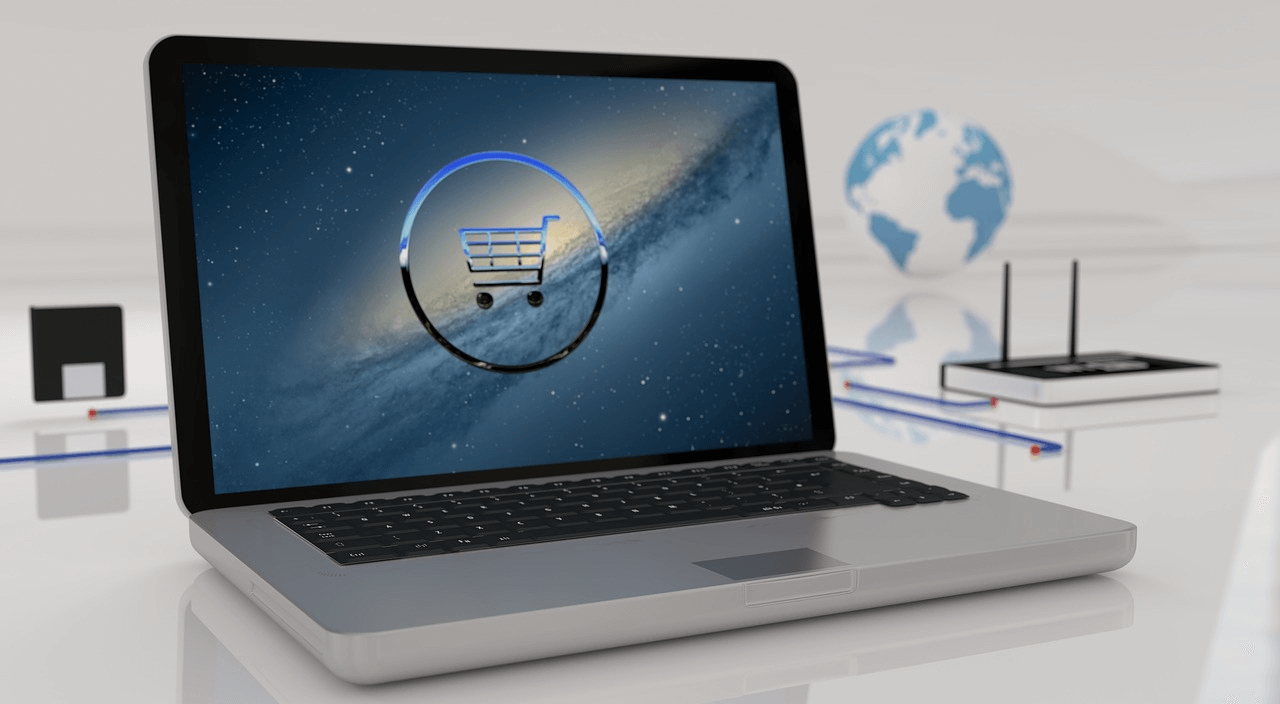
Redbubble emerges as a vibrant platform, ingeniously bridging the gap between unique, creative designs and the global market eager for personalized products. At its core, Redbubble operates as a marketplace that empowers artists and designers to showcase their artwork to a worldwide audience without the usual logistical hurdles of manufacturing and shipping. This ingenious model allows for the creation and sale of products ranging from apparel to home decor, each adorned with the artist's original designs.
The process is straightforward yet powerful. Artists simply upload their artwork onto the platform, select the types of products they wish to adorn with their designs, and set their profit margins. Redbubble then takes care of the rest—production, shipping, and customer service—freeing creators from the operational complexities of selling their art. This seamless integration of art and commerce not only provides a lucrative channel for artists and designers but also offers a treasure trove of unique items for consumers looking for something truly special and personalized.
Why Use Redbubble?
Choosing Redbubble as a platform to sell your creations is a strategic move for entrepreneurs, small business owners, designers, artists, brands, influencers, and even dropshippers seeking to expand their product offerings without the overhead of traditional retail. This platform stands out for its unique blend of technology, community, and commerce, designed to democratize the way art is sold and appreciated worldwide.
- Ease of Use
- Redbubble offers a user-friendly interface that simplifies the process of listing and selling products. Artists can easily upload their designs, select product categories, and instantly reach a global audience. The platform handles all aspects of the transaction, from payment processing to customer service, allowing creators to focus solely on their craft.
- No Upfront Costs
- One of the most compelling reasons to use Redbubble is the absence of upfront costs. Artists can set up a shop and start selling without any initial investment. This risk-free model is particularly appealing to emerging artists and small businesses looking to test the market.
- Access to a Global Market
- Redbubble's worldwide reach provides artists and designers with an opportunity to showcase their work to a vast audience beyond their local boundaries. This exposure is invaluable for building a brand and establishing a following.
- Customization and Variety
- The platform offers a wide array of products for customization, from clothing and accessories to home decor and stationery. This variety ensures that artists can find the right medium for their artwork, and consumers can find unique products that match their tastes.
- Artist Community and Support
- Redbubble fosters a supportive community of artists and designers, offering a space for collaboration, inspiration, and growth. The platform also provides resources and tools to help artists optimize their storefronts and increase their sales potential.
What Can You Sell on Redbubble?
Redbubble stands as a dynamic marketplace that empowers creators to bring their artistic visions to life across a multitude of products. This platform is not just about selling; it's about sharing your art with the world in a form that suits every preference and lifestyle. From clothing to home decor, Redbubble offers a canvas for every type of artist, designer, and entrepreneur.
- Clothing
- This category encompasses a broad range of apparel options, including t-shirts, hoodies, dresses, and leggings. Each piece can be customized with unique designs, allowing for personal expression and style.
- Accessories
- Redbubble's accessories line features items such as phone cases, stickers, tote bags, and face masks. These products offer customers a way to carry a piece of art with them in their daily lives, making everyday objects a statement of personal taste.
- Home Decor
- Artists can transform living spaces with custom-designed pillows, clocks, mugs, and blankets. These items allow customers to infuse their homes with personality and flair, turning the mundane into the extraordinary.
- Stationery
- For those looking to add creativity to their workspace or personal communication, Redbubble offers notebooks, greeting cards, and postcards. This allows artists to spread joy and inspiration through their designs.
- Wall Art
- Offering a range of options from posters to canvas prints, wall art allows artists to bring beauty and conversation into homes and offices. This category provides a platform for photographers, painters, and digital artists to showcase their work on a grand scale.
What Are the Best Designs to Sell with on Redbubble?
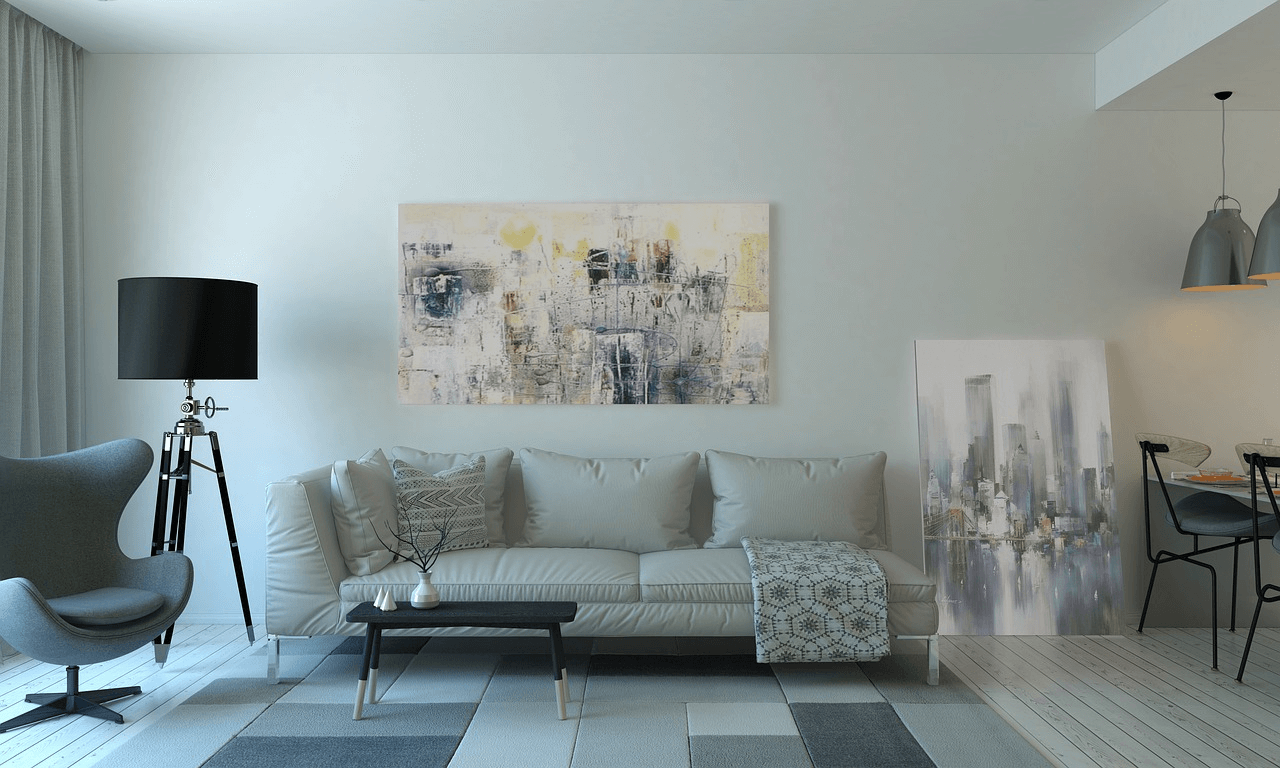
Navigating the vast creative seas of Redbubble, artists and designers often ponder which designs will capture the hearts and wallets of shoppers. The key lies not just in the aesthetic appeal but in tapping into trends, passions, and niches that resonate with the diverse Redbubble audience. Here, we explore the types of designs that consistently find success on this dynamic platform.
- Trend-Inspired Art
- Staying abreast of current trends and incorporating them into your designs can significantly boost visibility and sales. Whether it's pop culture, seasonal themes, or trending colors, these designs have a built-in audience eager for the latest and greatest.
- Niche Interests
- Designs that cater to specific hobbies, professions, or fandoms often perform exceptionally well. By focusing on a niche, you connect with a dedicated community that values personalized expressions of their interests.
- Inspirational Quotes
- Artwork featuring motivational, humorous, or poignant quotes continues to attract buyers looking for personal inspiration or a meaningful gift. The simplicity of text combined with creative typography can be powerful.
- Patterns and Abstract Designs
- Versatile and aesthetically pleasing, patterns and abstract art offer broad appeal. These designs translate well across a variety of products, from apparel to home decor, appealing to shoppers seeking to add a touch of artistry to their lives.
- Local and Geographic Themes
- Designs that celebrate specific locations, landmarks, or cultural elements of a city or country can tap into the sentiments of locals and travelers alike. These designs often become keepsakes that evoke memories and a sense of belonging.
Pros and Cons of Selling on Redbubble

Embracing the Redbubble platform for selling artistic creations offers a blend of opportunities and challenges that artists, designers, and entrepreneurs should consider. This marketplace extends a canvas for creativity, allowing for the sale of unique designs on a variety of products. Yet, navigating this space requires an understanding of both its advantages and limitations.
Pros
- Broad Audience Reach
- Redbubble connects creators with a global audience, offering a vast marketplace to sell art without geographical constraints. This exposure is invaluable for building a brand and reaching potential customers across the world.
- No Upfront Costs
- Creators can set up a shop and start selling their designs without needing to invest in inventory or production facilities. Redbubble handles all aspects of manufacturing and shipping, reducing the financial burden on artists.
- Creative Freedom
- Artists retain control over their designs and can choose from an extensive range of products to print their art on, from apparel to home decor, providing a diverse portfolio of items to potential buyers.
- Artist Community
- The platform fosters a supportive environment where artists can connect, share insights, and grow together. This community aspect can be a source of inspiration and collaboration.
Cons
- Competition
- With thousands of artists and millions of designs, standing out on Redbubble can be challenging. Creators must invest time in marketing and optimizing their storefronts to attract attention.
- Profit Margins
- While Redbubble removes the hassle of production and logistics, it also takes a significant portion of the sales price, which can limit profit margins for artists. Pricing strategies need careful consideration.
- Limited Control Over Product Quality
- As production and shipping are managed by Redbubble, artists have limited control over the quality of the final product delivered to customers. This can affect customer satisfaction and brand reputation.
- Dependence on Platform Policies
- Selling on Redbubble means adhering to its policies and guidelines, which can change. Artists are subject to the platform's rules, which can impact visibility and sales.
How to Create Your Redbubble Store and Sell Things?
Creating a successful Redbubble store is an exciting journey for artists, designers, and entrepreneurs looking to explore the vast potential of print-on-demand (POD) platforms. With the right approach, your Redbubble store can become a significant source of passive income, allowing you to sell your designs worldwide without the hassle of inventory management or shipping logistics. Here's how to set up your store and start selling:
Choose Your Niche
Identifying a specific niche or theme for your Redbubble store can significantly impact its success. Whether it's pop culture, nature, abstract art, or motivational quotes, a focused niche helps attract a dedicated audience. It's essential to research current trends while also considering your passions and strengths. As RaggySparra from Reddit points out, being aware of Redbubble's recent changes, including a new set of fees, is crucial for managing your earnings effectively.
Create High-Quality Designs
The cornerstone of a successful Redbubble store is the quality of your designs. High-resolution, original artwork that resonates with your target audience can set your store apart. Consider various product formats and how your designs will adapt to items like stickers, t-shirts, and phone cases. TheNaughtyYarnist, also from Reddit, recommends diversifying by placing designs on multiple POD platforms, not just Redbubble, to maximize income potential and reduce reliance on a single source.
Optimize Your Listings
To maximize visibility and sales, optimize your product listings with relevant keywords, engaging descriptions, and high-quality images. Understanding SEO principles can enhance your store's discoverability on Redbubble and search engines, drawing more potential customers to your products. aarongy, another Reddit user, bluntly advises, "Get out while you can and sell on a different platform before you waste any of your valuable time."
Promote Your Store
Leveraging social media platforms, blogs, and online communities can significantly increase your store's exposure. Sharing your creation process, featuring customer reviews, and offering promotions can engage your audience and drive traffic to your store. randyspotboiler from Reddit emphasizes that without promotion, a lot of designs, and a good plan, you won't sell much.
User Comments
- RaggySparra on Reddit: "Be aware you might get some snarky answers - you're joining just as Redbubble has introduced a huge new set of fees."
- TheNaughtyYarnist on Reddit: "Invest time in finding platforms other than Redbubble and put your designs on all of them."
- aarongy on Reddit: "Get out while you can and sell on a different platform before you waste any of your valuable time."
- randyspotboiler on Reddit: "That without promotion, a lot of designs, and a good plan you won't sell much."
- A Quora user named Jeffrey Brown explains: "Orders from independent artists are printed and shipped by 3rd-party printers around the world directly to your customer," highlighting the ease of Redbubble's fulfillment process and how it removes the burden of shipping logistics from the artist.
Incorporating these insights directly from the Redbubble and Quora communities into your strategy can help navigate the complexities of selling on the platform. By staying informed, diversifying your approach, and actively promoting your store, you can turn your creative passion into a profitable venture.
How to Make Money on Redbubble?
Unlocking the potential to generate revenue on Redbubble requires a blend of creativity, strategy, and engagement. This platform offers a unique opportunity for artists, designers, and entrepreneurs to monetize their artwork by selling it on a wide range of products to a global audience. Here's how to tap into that potential and start making money on Redbubble.
- Optimize Your Artwork for Various Products
- Ensuring your designs are versatile enough to look great on everything from stickers to duvet covers can significantly increase your sales opportunities. Diversifying your product range caters to different customer preferences, maximizing your earning potential.
- Set Competitive Pricing
- While Redbubble sets a base price for products, you control the artist margin or markup. Adjusting your pricing strategy to balance attractiveness to buyers and profitability for you is key. Researching competitor pricing can offer insights into what the market bears.
- Utilize SEO Practices
- Incorporate relevant keywords in your product titles, descriptions, and tags to improve search visibility both on Redbubble and search engines. This approach can drive more traffic to your store, increasing the likelihood of sales.
- Promote Your Store
- Leverage social media, blogs, and other digital platforms to showcase your Redbubble products. Sharing your story, the inspiration behind your designs, and engaging with your audience can build a loyal customer base.
- Analyze Performance
- Redbubble provides analytics tools to track your store's performance. Use these insights to understand which designs are popular, what products are selling, and during which times your sales peak. This data can inform your future design and marketing decisions.
- Engage with the Redbubble Community
- Participating in the Redbubble community can lead to increased exposure for your store. Engaging with other artists, participating in challenges, and being active in forums can drive traffic to your profile.
What Are Redbubble Alternatives?
Exploring alternatives to Redbubble opens up new avenues for artists, designers, and entrepreneurs to showcase and sell their creations. While Redbubble offers a vast marketplace for diverse products, several other platforms also provide unique benefits, catering to different needs and preferences. Among these alternatives, three stand out for their distinctive offerings and advantages.
PrintKK
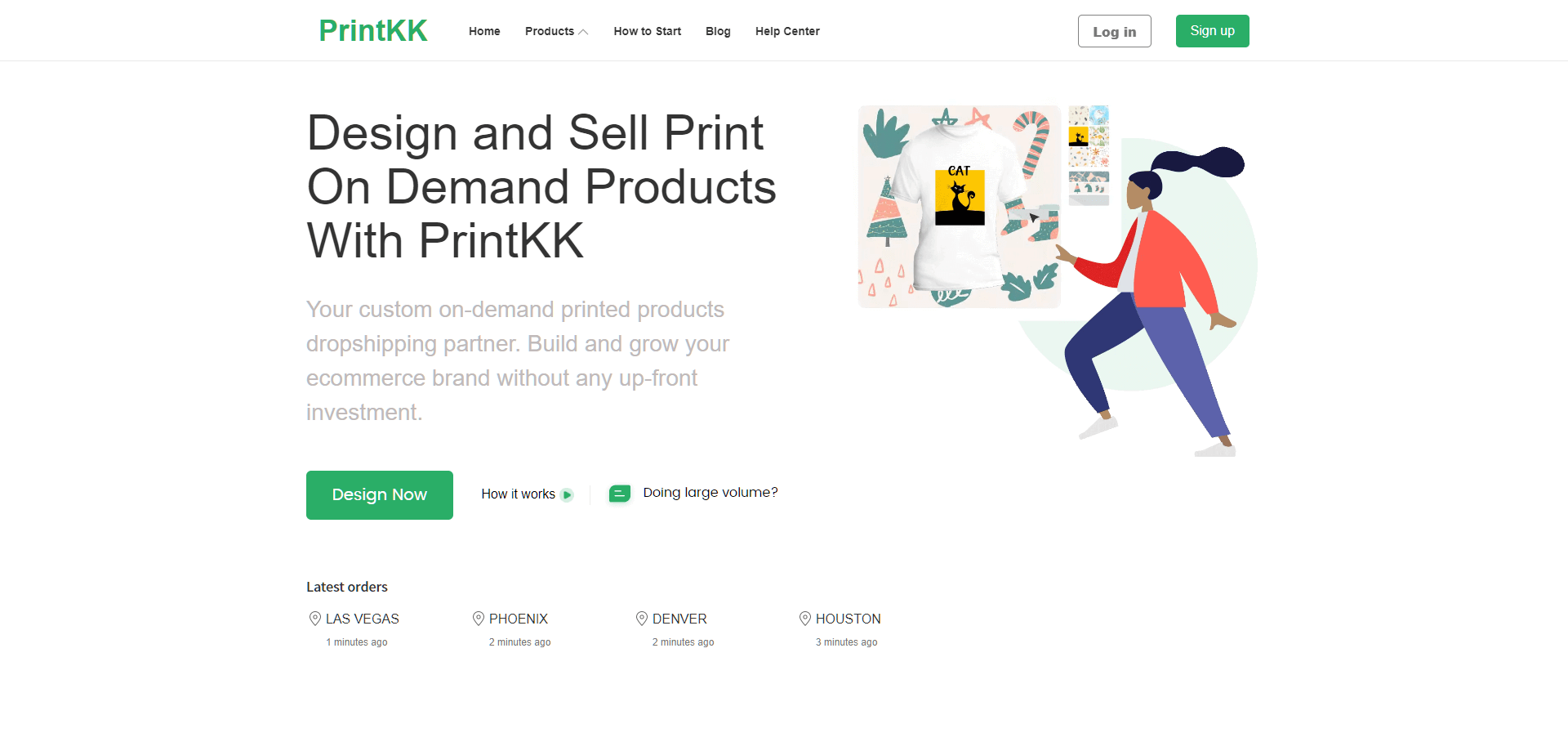
Choosing PrintKK for your custom face masks and other print-on-demand products means partnering with a platform dedicated to supporting your business's growth and success. PrintKK distinguishes itself with several key features:
- Free Design Capabilities
- Leveraging a state-of-the-art Mockup Generator, PrintKK enables creators to design and visualize a diverse range of products, from stylish home decor to trendy T-shirts, directly within the browser. This tool streamlines the design process, allowing for easy sampling and ensuring that each unique product, among the many available categories, can be crafted to perfection before listing.
- Round-the-Clock Support
- PrintKK prides itself on offering 24/7 merchant support, ensuring that whether you have questions about an order or need production advice, assistance is always available.
- Seamless Store Integration
- Effortless Order Fulfillment
- Once a product listing is created, PrintKK takes over the management of printing and shipping for each sale, providing a hassle-free experience for the seller and ensuring customer satisfaction.
TeeSpring (now Spring)
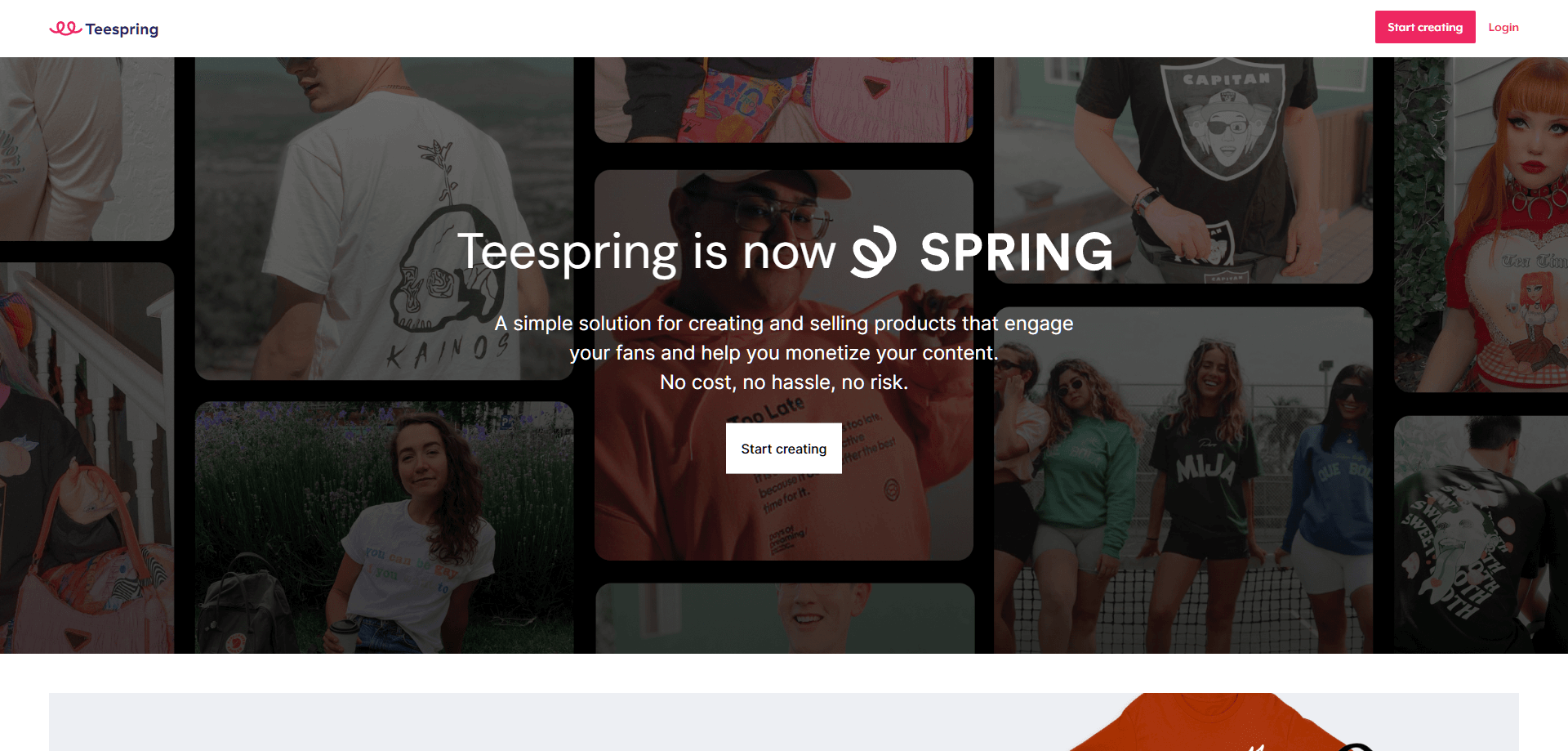
Spring offers a direct-to-consumer model that allows creators to design and sell a wide range of products. Its key features include:
- Brand Building Tools
- Spring provides tools that help creators build and promote their brand, including customizable storefronts and promotional campaigns.
- Integrated Marketing
- The platform offers integration with social media platforms, enabling creators to market directly to their followers and potential customers.
Society6
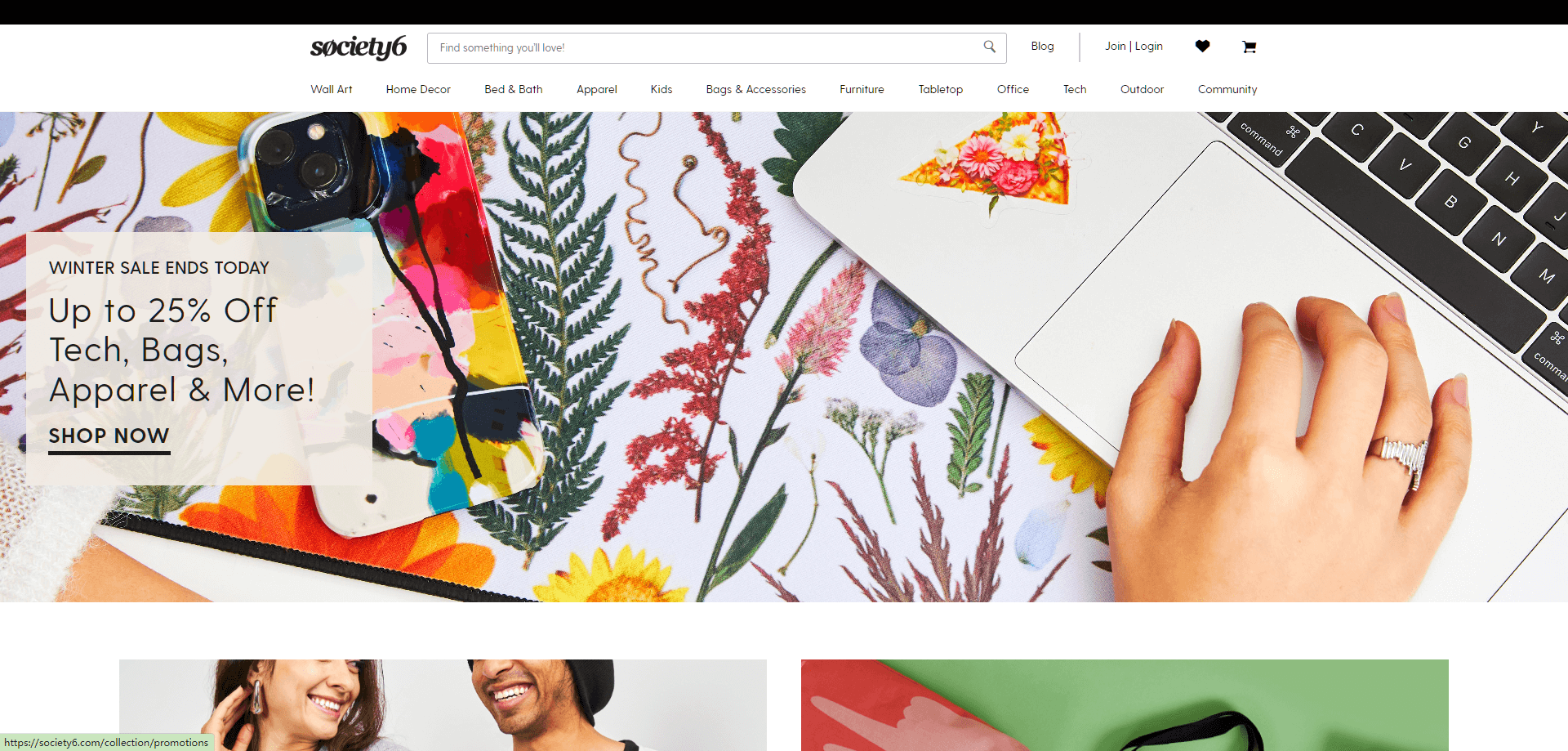
Society6 is popular among artists and designers for its focus on art and design-driven products. It stands out for:
- Artist-Centric Community
- Society6 fosters a community of artists, providing a space for creators to share their work and connect with other artists.
- Diverse Product Range
- The platform offers a wide array of products, from art prints to home decor, allowing artists to apply their designs to different mediums.
Conclusion
Embarking on the journey of selling on Redbubble opens a world of opportunity for entrepreneurs, artists, and designers alike. This platform not only provides a space to showcase creativity but also offers a robust model for turning artistic endeavors into profitable ventures. The key to success lies in understanding the marketplace dynamics, optimizing product listings, and engaging actively with both the community and potential customers. With dedication, the right strategy, and a bit of creativity, Redbubble can become a significant revenue stream for creatives from all walks of life.
As we conclude, remember that the journey of selling on Redbubble is an evolving process. The platform's environment is dynamic, with trends and consumer preferences constantly changing. Staying informed, being adaptable, and continuously exploring new designs and marketing strategies will help in keeping your store fresh and relevant. Whether you're just starting or looking to expand your presence, Redbubble offers a unique and rewarding avenue to connect with a global audience and share your artistic vision with the world.
FAQs
Is selling on Redbubble profitable?
Yes, selling on Redbubble can be profitable. Success depends on your design's appeal, marketing efforts, and product selection.
Is Redbubble better than Etsy?
Choosing between Redbubble and Etsy depends on your needs. Redbubble is print-on-demand, while Etsy offers broader handmade goods.
How much does it cost to sell on Redbubble?
Selling on Redbubble is free. You earn through the markup added to the base price of products.
Does Redbubble own your art?
No, Redbubble does not own your art. Artists retain full rights to their work while selling on the platform.
Is it hard to sell on Redbubble?
Selling on Redbubble varies; it demands unique designs, effective marketing, and engagement to stand out and achieve sales success.
Can I sell directly from Redbubble?
Yes, you can sell directly on Redbubble. The platform allows artists to upload designs and sell them on various products easily.










 Global Shipping
Global Shipping




























